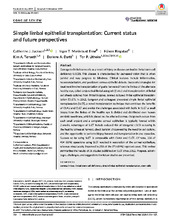| dc.contributor.author | Jackson, Catherine | en_US |
| dc.contributor.author | Ernø, Ina Myklebust | en_US |
| dc.contributor.author | Ringstad, Håkon | en_US |
| dc.contributor.author | Tønseth, Kim Alexander | en_US |
| dc.contributor.author | Dartt, Darlene Ann | en_US |
| dc.contributor.author | Utheim, Tor Paaske | en_US |
| dc.date.accessioned | 2020-06-16T16:44:07Z | |
| dc.date.available | 2020-06-16T16:44:07Z | |
| dc.date.issued | 2019-12-04 | |
| dc.Published | Jackson C, Ernø IM, Ringstad H, Tønseth KA, Dartt DA, Utheim TP. Simple limbal epithelial transplantation: Current status and future perspectives: Concise review. Stem Cells Translational Medicine. 2020;9:316–327. | eng |
| dc.identifier.issn | 2157-6580 | |
| dc.identifier.issn | 2157-6564 | |
| dc.identifier.uri | https://hdl.handle.net/1956/22636 | |
| dc.description.abstract | Damage to limbal stem cells as a result of injury or disease can lead to limbal stem cell deficiency (LSCD). This disease is characterized by decreased vision that is often painful and may progress to blindness. Clinical features include inflammation, neovascularization, and persistent cornea epithelial defects. Successful strategies for treatment involve transplantation of grafts harvested from the limbus of the alternate healthy eye, called conjunctival‐limbal autograft (CLAU) and transplantation of limbal cell sheets cultured from limbal biopsies, termed cultured limbal epithelial transplantation (CLET). In 2012, Sangwan and colleagues presented simple limbal epithelial transplantation (SLET), a novel transplantation technique that combines the benefits of CLAU and CLET and avoids the challenges associated with both. In SLET a small biopsy from the limbus of the healthy eye is divided and distributed over human amniotic membrane, which is placed on the affected cornea. Outgrowth occurs from each small explant and a complete corneal epithelium is typically formed within 2 weeks. Advantages of SLET include reduced risk of iatrogenic LSCD occurring in the healthy cornea at harvest; direct transfer circumventing the need for cell culture; and the opportunity to perform biopsy harvest and transplantation in one operation. Success so far using SLET is comparable with CLAU and CLET. Of note, 336 of 404 (83%) operations using SLET resulted in restoration of the corneal epithelium, whereas visual acuity improved in 258 of the 373 (69%) reported cases. This review summarizes the results of 31 studies published on SLET since 2012. Progress, advantages, challenges, and suggestions for future studies are presented. | en_US |
| dc.language.iso | eng | eng |
| dc.publisher | Wiley | eng |
| dc.rights | Attribution-NonCommercial CC BY-NC | eng |
| dc.rights.uri | http://creativecommons.org/licenses/by-nc/4.0/ | eng |
| dc.subject | cornea | eng |
| dc.subject | limbus | eng |
| dc.subject | limbal stem cell deficiency | eng |
| dc.subject | simple limbal epithelial transplantation | eng |
| dc.subject | stem cells | eng |
| dc.title | Simple limbal epithelial transplantation: Current status and future perspectives | en_US |
| dc.type | Peer reviewed | |
| dc.type | Journal article | |
| dc.date.updated | 2020-01-30T15:46:07Z | |
| dc.description.version | publishedVersion | en_US |
| dc.rights.holder | Copyright 2019 The Author(s) | |
| dc.identifier.doi | https://doi.org/10.1002/sctm.19-0203 | |
| dc.identifier.cristin | 1771177 | |
| dc.source.journal | Stem Cells Translational Medicine | |

